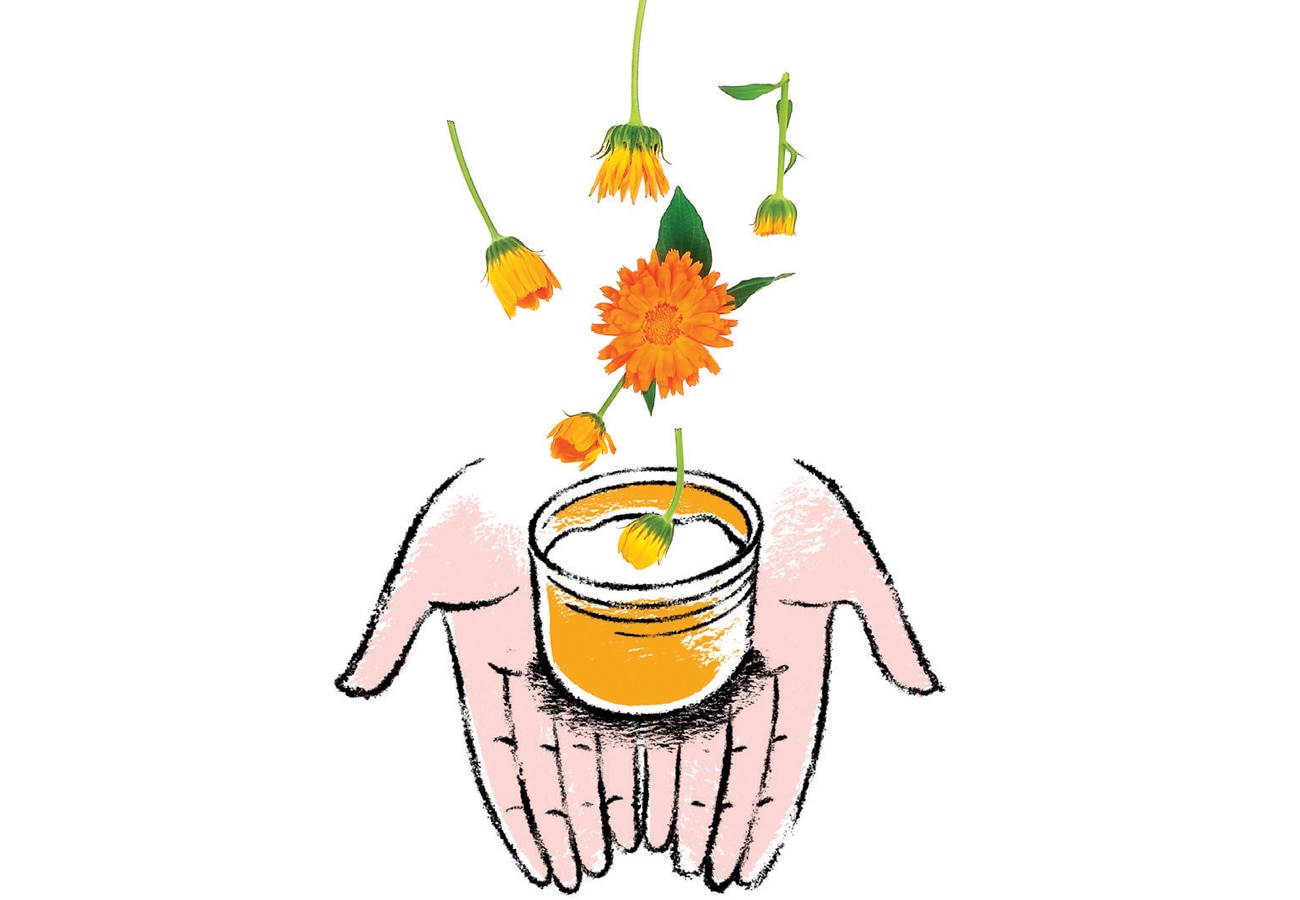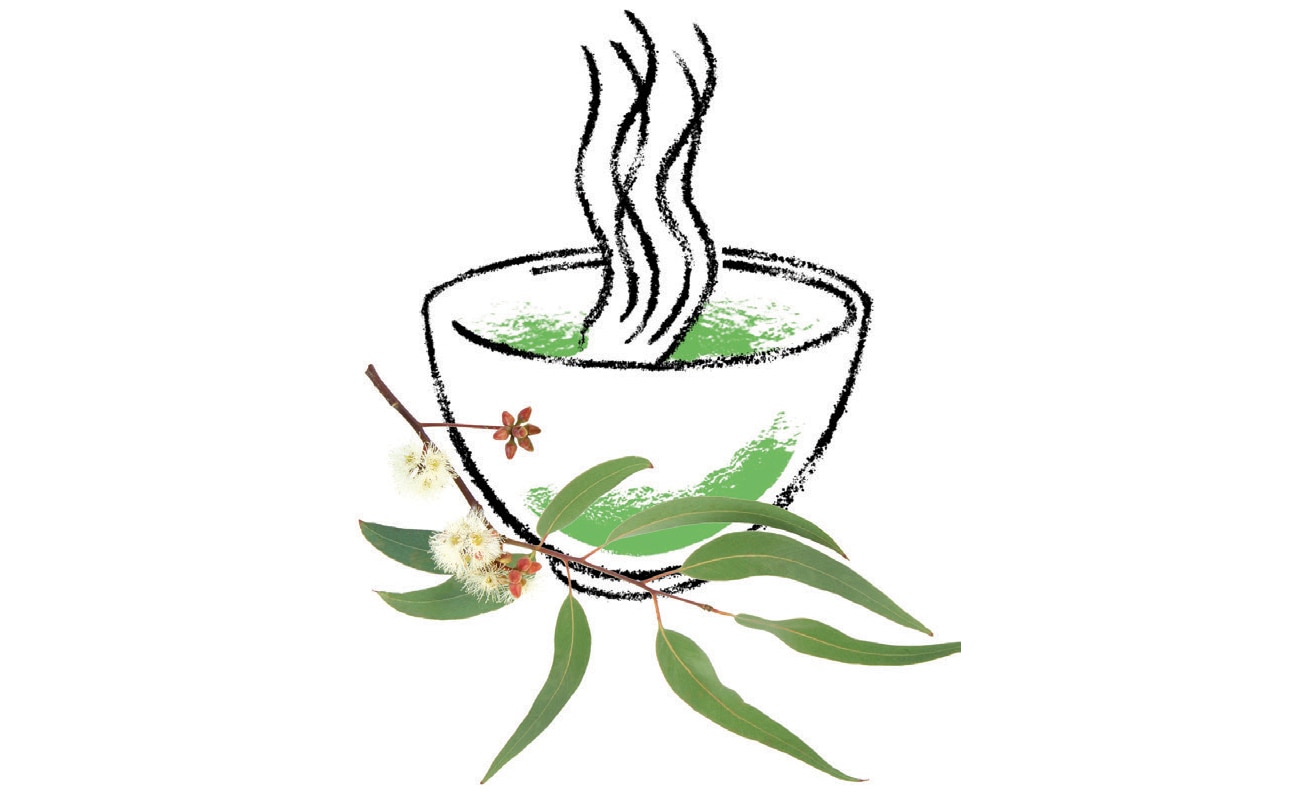- HOME
- /
- Better Living
- /
Home Remedies from Around the World
These 13 folk treatments are proven to work
 Illustrations by Ed Fotheringham
Illustrations by Ed Fotheringham
Many of us fall back on home treatments for ailments, whether they're proven to be effective or not. We asked editors at some of our Reader’s Digest (RD) editions around the world to share those that work for them—and then we checked out which ones are backed by research. Here are our favourites.
FRANCE VINEGAR Fights Infection
French folklore has it that during the 17th-century plague, a gang of four thieves would rob corpses, yet never catch the plague themselves. Supposedly, anointing their bodies with a concoction of vinegar and herbs protected them.
The so-called vinaigre des quatrevoleurs (four thieves’ vinegar) is used today in the belief it fights infection. Many of the ingredients steeped init—garlic, rosemary, sage, lavender, thyme, juniper berry, black pepper and more—are proven to have antibacterial properties.
“I know people who consume this regularly as an antibacterial,” says Stéphane Calmeyn, Paris-based editor of RD. He adds that a friend of his with Type 2 diabetes credits it with helping regulate his blood sugar.
Though more research is needed, there is evidence that vinegar, particularly apple cider vinegar, can affect blood sugar levels: it delays the rate at which the stomach empties and starch is digested, which reduces the blood sugar spike after a meal. But check with your doctor before adding it to your diet, particularly if you are taking blood-sugar-lowering medications.
Apple cider vinegar may also prevent overeating. A small Swedish study found that those who consumed vinegar with a meal reported feeling more satiated than those who didn’t consume vinegar. That could prevent unhealthy snacking later in the evening. It’s best not to drink vinegar undiluted, as its acidity could damage tooth enamel. Instead, add one or two teaspoons to water or tea.

MALAYSIA PAPAYA Aids Digestive Health
When her husband got food poisoning while travelling in Malaysia in 2017, editor Bonnie Munday heeded a recommendation for a local remedy.
“We didn’t have any medicine for tummy troubles, but our hotel manager advised eating ripe papaya,” says Bonnie, who is on RD’s International Edition team and is based in Toronto. She was skeptical but bought some of the fruit from a beach vendor. “An hour or two after my husband ate it, he felt so much better.
”A study from Obafemi Awolowo University in Nigeria published in the Journal of Medicinal Food found that papaya, the orange-fleshed fruit that grows in the tropics, fights intestinal parasites. When researchers gave a papaya seed preparation to children who tested positive for intestinal parasites, it was shown to be antihelminthic (capable of eliminating parasitic worms) and anti-amoebic(capable of destroying or suppressing amoebas); it treated their parasites without harmful side effects.
And results of a double-blind placebo-controlled trial that were published in the journal Neuroendocrinology Letters in 2013 showed that volunteers with digestive complaints like bloating and constipation had significant improvements after ingesting a papaya pulp supplement called Caricol. Papaya is also rich in vitamin C, and high in water and fibre content, which regulates bowel activity.“Ever since that time in Malaysia,” says Bonnie, “if we see papaya at the store, we buy it, just for overall digestive health.”

GERMANY CALENDULA Calms Inflammation
“Many people in Germany consider calendula a miracle cure, and have their own recipe for a balm,” says Annemarie Schäfer, who works on the RD team in Stuttgart.
Her cousin Marlen, a teacher, recalls that when her mother grew calendula—also called marigold—in her garden, she’d mix their orange and yellow heads with warm pork fat (you can also use petroleum jelly, beeswax or olive oil). After a day of steeping, the mixture was strained and jarred, to be used on rough hands, insect bites, acne and other skin irritations.
High levels of antioxidants in the dried petals reduce the damage caused by free radicals. Laboratory and animal research has shown the flowers contain anti-inflammatory and antimicrobial components that prevent infection and heal wounds by helping form new blood vessels and tissue. In patients with venous leg ulcers treated with either calendula ointment or saline solution dressings, calendula helped ulcers heal much faster.
NETHERLANDS LICORICE Relieves Sore Throat
Licorice-based candy, called dropjes, are as Dutch as wooden shoes—but while few farmers still wear wooden shoes, everybody eats dropjes. “It's sort of national pride,” says editor Paul Robert in Amsterdam. “And you can get them everywhere—supermarkets, newsstands, pharmacies. They come in all shades of brown and black with flavours ranging from very sweet to very salty.
”Besides being somewhat of an addiction for the Dutch, it’s widely known in northern European countries that licorice also serves a medicinal purpose: sore-throat relief. Indeed, a 2013 randomized, double-blind study of 236 people by the Medical University of Vienna found that patients who gargled a licorice solution before going into surgery requiring throat intubation had a lower risk of sore throat after the surgery.
The extract of the licorice root, Glycyrrhizin, tastes sweeter than sugar, despite having a zero glycaemic index. But it’s not safe to consume more than 100 milligrams per day, as it can dangerously reduce blood potassium levels. (A cup of licorice tea contains roughly 30 milligrams, according to The British Medical Journal.)
“When I was a child,” says Paul, “the best thing about having a cold was that I’d get lots of dropjes. Sucking on them soothed my throat back then, and still does now.” Dropjesare an acquired taste, especially the salty ones. “Once,” he recalls with a laugh, “I gave them to an American friend, who told me they tasted just as terrible as the raw herring and smoked eel I’d given her earlier!”

PORTUGAL GARLIC Gets Rid of Warts, Corns, Calluses
“We use a lot of garlic in our cuisine,” says editor Mario Costa in Lisbon. “But some people, especially in rural areas, also use it to get rid of warts,corns and calluses.”
Corns and calluses both involve a buildup of skin at pressure points on the foot, while warts are small growths that can occur anywhere on the body and are caused by the human papillomavirus, or HPV. Research from 2005 published in the International Journal of Dermatology showed that warts treated daily with a garlic extract disappeared for all the study subjects within two weeks, and corns disappeared for 80 per cent of subjects after three weeks.
Garlic has antibacterial properties (thanks to its main component, allicin) and its antiviral effect may attack the virus that causes warts. Be careful not to allow raw garlic to touch healthy skin as it can cause irritation and damage similar to a burn.
It worked for RD reader Georginaof central Portugal. Here’s what she told us on Facebook: “A few years ago, when my friend’s aunt noticed me limping because of a callus, she told me about this home remedy. I baked a few garlic cloves, crushed them, and applied the pulp to the callus, avoiding healthy skin. I covered it with gauze and changed this compress daily. Although the smell was a little intense, after five days, my callus disappeared.
”SLOVENIA ST. JOHN’S WORT Soothes Skin
“We use a balm containing St. John’swort to promote wound healing and soothe skin,” says editor MajaLihtenvalner in Ljubljana. St. John’swort is a plant with yellow flowers that’s native to Europe, northern Africa and southwestern Asia.
She describes how her friend Neven, a consultant and olive oil producer in his 50s, remembers his grandmother always having the remedy in her kitchen. “Neven would spend summer vacations at her house on the Adriatic Sea, and often got sunburnt. His granny would apply a mixture of St. John’s wort and olive oil to his painful skin.” She also used it on bruises and insect bites. “He says it was always a relief.”
Animals studies out of Turkey in the past few years have shown that St. John’s wort promotes wound healing and also relieves burns; rats treated topically with St. John’s wort four times a day experienced more rapid healing than those in the other groups.
And a 2010 Iranian randomized, double-blind clinical trial of 144women published in the Journal of Alternative and Complementary Medicine showed that women who had undergone caesarean sections and applied a St. John’s wort ointment three times a day for 16 days had improved wound healing and less pain and scarring than those in the placebo and control groups.
Ingesting St. John’s wort can also treat mild to moderate depression, and menopause symptoms such as hot flushes. But speak to your doctor before taking it, because it can cause serious side effects and drug interactions.

MEXICO ARNICA Reduces Bruising; ALOE VERA Relieves Burns
Arnica is popular in Mexico, says RD editor Luis Eduardo Pineda in Mexico City. “I played basketball when I was a kid, and sometimes my fingers would get painfully bruised. My mother would rub them with arnica balm, and in a few days the bruising would be gone.” These days, Luisuses it for sore muscles. “I keep arnica balm in my first-aid kit.
”Anti-inflammatory arnica, from the same family as asters and daisies, is said to reduce swelling and bruising. A 2013 review of 174 people with hand arthritis found that arnica gel reduced pain and improved function in the hand as effectively as an ibuprofen gel. As arnica can be poisonous, it should not be taken by mouth.
Luis has another go-to: aloe vera, or sábila. A review of four studies from Asia, published in the journal Burns, concluded that aloe mucilage (the gel inside its leaves) and some aloe products can accelerate healing of minor burns several days faster than conventional medication. “Not long ago, I accidentally grabbed the handle of a hot pan,” recalls Luis. “Luckily I keep sábila in a flowerpot on my patio, so I got relief quickly.”

BRAZIL MACELA Soothes Cough
“When we were kids, if we had a cough my grandmother would whip one egg yolk with sugar and, when it had whitened, combine the mixture with a cup of macela [alsospelled ‘marcela’] tea,” says Tanara Vieira, a designer for RD from Rio Grande do Sul. “It tasted so good that my sister, my cousins and I used to pretend we were coughing so she would give it to us.
”Across Brazil, plants have long been used medicinally. A review of several studies published in 2014 in the Brazilian Journal of Pharmacognosy sought to show whether a variety of plants of the southern Rio Grande region offers the health benefits they are purported to. The review showed that indeed, in several pre-clinical studies, there’s evidence Tanara’s grandmother was right: macela (Achyroclinesatureoides), which is a plant in the daisy family, appears to be antispasmodic, helping relieve a cough. It’s also muscle-relaxing, anti-inflammatory and analgesic.
SPAIN OLIVE OILS Softens Earwax
We need earwax because it keeps the skin inside the ear moisturized and helps prevent dirt and bacteria from reaching the inner ear. But a buildup of too much wax can form a plug, contributing to hearing loss, ringing in the ears or dizziness. Plugs, called cerumenosis, can happen if you use cotton swabs, which push wax in, or if you're naturally prone to the buildup. It can happen especially in elderly people or those who wear hearing aids.
People in many parts of the world find that a little warm oil, such as almond or olive, can soften the wax, unplugging the ear canal. Natalia Alonso, Madrid-based RD editor, says her sister-in-law, Car-men, goes to her doctor to get built-up earwax removed, but she sometimes treats it herself.
“On a recent beach holiday in Galicia, she noticed her hearing had diminished, and knew what the problem was,” says Natalia. “So she dipped a cotton swab in warm olive oil and let a little drip into her ear, and soon the clog disappeared.
”A University of Southampton re-view of 26 clinical trials found that earwax softeners are effective, and that side effects are rare. Nevertheless, it’s recommended you check with your doctor before attempting self-treatment of ear issues.

NEW ZEALAND MANUKA HONEY
Helps Many AilmentsFor centuries the Maori community of New Zealand has relied on the bark and leaves of the manuka bush—native to New Zealand and sometimes called a tea tree—for its health-giving properties. More recently, the honey made from its white or pink flowers is the star: research shows this type of honey has much higher levels of antibacterial and wound-healing compounds than others.
“Our whole family uses manuka honey,” says Auckland-based Yulia McKenzie, who works in advertising with the New Zealand edition’s RD team. She says it’s a great-tasting way to keep the immune system healthy.“We use it on waffles and cereal, and as a sugar substitute for smoothies.” In winter months, Yulia’s family uses the honey to soothe sore throats and coughs.
Research from Cardiff University showed that components of manuka honey can stimulate immune cells, increasing our ability to fight bacteria. (It’s especially effective against a strain of streptococcus.) Another study showed its antimutagenic, anti-oxidant, and anti-inflammatory qualities may even help prevent or treat cancer.
One small study showed that manuka honey may improve dental health. Subjects given a chewable form of the honey had a 34 percent reduction in plaque, and a similar reduction in bleeding for those with gingivitis, compared with study participants directed to chew sugarless gum. Some people use this honey as a facial mask to soften and brighten their skin. Says Julia, “I use it regularly, and I must say my skin looks amazing!
”Check the label to make sure it’s genuine manuka honey from New Zealand. Labels also carry a UMF (UniqueManuka Factor) grade up to 26; the higher the number, the more healthful compounds it contains.
AUSTRALIA EUCALYPTUS OIL Clears Sinuses
Adele Burley uses eucalyptus oil to alleviate cold symptoms like nasal congestion. “It helps clear the airways,” says the Sydney-based senior art designer for RD Australia. “I add a few drops to a bowl of steaming water, cover my head with a towel and breathe in.”In a randomized double-blind trial of 152 people, published inThe Laryngoscope in 2009, German researchers found that the main component of eucalyptus oil—1,8-cineole, or eucalyptol—was effective and safe for treating sinusitis, helping clear nasal blockages and mucous.
The eucalyptus tree is native to Australia, and the oil from its leaves is similarly helpful if you have perennial allergic rhinitis—a chronically stuffy or runny nose due to pet dander, mould or dust. A South Korean study published in 2016 in Evidence-Based Complementary and Alternative Medicine found that essential oils including 1,8-cineole alleviated symptoms. Of 54 people aged 20 to 60, those who inhaled the oils for five minutes twice daily over seven days also had better sleep versus those who inhaled a placebo.
Don’t ingest eucalyptus oil, though, and avoid applying it directly to your skin; if it’s undiluted it could cause irritation.

FINLAND SAUNA Boosts Circulation
“The steam sauna has been a Finnish tradition for hundreds of years, and most Finns go regularly,” says Ilkka Virtanen, Helsinki-based editor of RD.“It’s good for heart health.”
A sauna is typically a room heated to between 80 degrees and 100 degrees Celsius. When a person sits sweating in a sauna, their heart rate increases, as does blood flow in the skin, boosting circulation as much as low to moderate exercise does. Risk of heart attack and stroke are reduced, according to a2015 study of Finnish men published in JAMA Internal Medicine. That research also showed that sitting in a sauna two to three times a week lowers the risk of dying from any cause by 24 per cent. Another study showed that 15 minutes a day in a sauna five days a week may help ease mild depression.
Ilkka’s friend Ben, 76, credits the sauna with his good health. “I go practically every day,” says Ben. “You feel so pure and healthy afterwards, and your soul is relaxed.
”If you’re new to the sauna, start with five or 10 minutes; 20 minutes is the maximum. And if you have heart disease, or high or low blood pressure, speak to your doctor about whether a sauna is safe. Drink plenty of water, and avoid alcohol before or during the sauna; alcohol causes further dehydration.






